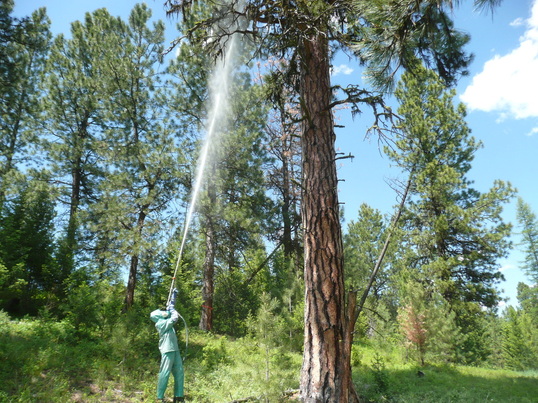Pine Beetle Spraying

Carbaryl application near Ovando, MT
Spraying lodgepole, ponderosa and whitebark pine trees is the most effective and often times most economical way to prevent mountain pine beetle attack. Currently, there are three chemicals labeled to prevent pine beetle attack. These chemicals are carbaryl, permethrin and bifenthrin. All three chemicals are very effective (> 95%) at preventing bark beetle attacks regardless of tree or beetle species. The most popular chemical and the choice of the USDA Forest Service is carbaryl. Carbaryl belongs to the family of insecticides known as carbamates, it's most common trade name is Sevin and it has been in use much longer than permethrin or bifenthrin. Carbaryl is the most common insecticide used by homeowners to reduce insect damage in gardens. The Forest Service has conducted numerous studies on it's effectiveness and potential environmental impacts and continues to only use carbaryl when spraying campgrounds and administrative areas to prevent pine beetle attack. The other two chemicals available are permethrin, commonly known as Astro, and Bifenthrin, commonly known as Onyx. Permethrin and bifenthrin are very similar chemicals and both belong to the family of insecticides known as pyrethroids. In general they are more environmentally friendly than carbaryl, and are used more often in urban pest control situations, due to their lower toxicity to mammals, ease of use for applicators and their clear consistency (they are not messy like carbaryl). Common household uses for permethrin include the active ingredient in pet flea collars, treatment for head lice and treatment for scabies (surprisingly it is occasionally taken orally in pill form, although it is usually administered as a topical cream). Below is a summary of advantages and disadvantages of carbaryl, permethrin and bifenthrin.
CARBARYL
Advantages
- Provides 2 years of protection from a single application
- Found to be most effective chemical by the Forest Service
- Least toxic chemical to fish
- Usually cheaper to spray per year of protection than other chemicals
Disadvantages
- Most toxic chemical to mammals
- Can leave a white film on decks, siding, roofs and windows
PERMETHRIN
Advantages
- Overall the most environmentally friendly chemical
- Least toxic chemical to mammals
- Doesn’t make a mess
Disadvantages
- Only provides 1 year of protection per application
- More expensive to spray per year than carbaryl
BIFENTHRIN
Advantages
- Doesn’t make a mess
Disadvantages
- Most toxic chemical to aquatic invertebrates
- More expensive to spray per year than carbaryl
- Only provides 1 year of protection per application
Advantages
- Provides 2 years of protection from a single application
- Found to be most effective chemical by the Forest Service
- Least toxic chemical to fish
- Usually cheaper to spray per year of protection than other chemicals
Disadvantages
- Most toxic chemical to mammals
- Can leave a white film on decks, siding, roofs and windows
PERMETHRIN
Advantages
- Overall the most environmentally friendly chemical
- Least toxic chemical to mammals
- Doesn’t make a mess
Disadvantages
- Only provides 1 year of protection per application
- More expensive to spray per year than carbaryl
BIFENTHRIN
Advantages
- Doesn’t make a mess
Disadvantages
- Most toxic chemical to aquatic invertebrates
- More expensive to spray per year than carbaryl
- Only provides 1 year of protection per application
